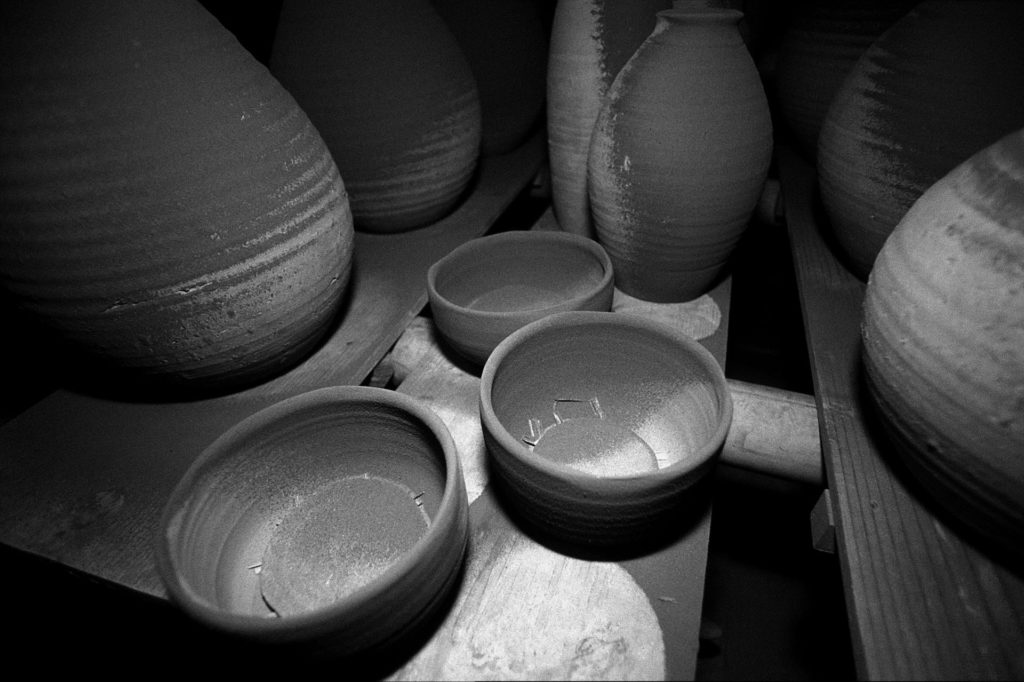“Beer tastes better in Bizen! ” he said. “From Bizen cups anyway.” He had been sitting in the corner all night and, as the discussion moved from politics to the arts to nuclear fusion, he hadn’t uttered a peep. Silence followed as we weighed the gravity of his statement. We considered ourselves experts on any beer-related topic and a heated debate ensued, fueled, of course, by copious amounts of ale. The conclusion: A fact-finding mission to Bizen, in Okayama Prefecture, to see for ourselves.

Bizen pottery comes from one of Japan’s six oldest kilns—in fact, the oldest. The history can be traced back to the Heian Period, which makes it more than a thousand years old. Bizen pottery’s distinctive red—to a deep chocolate-brown—coloring is due to the local iron-rich clay, which distinguishes it from its counterparts. The stoneware is considered by many to be the quintessence of Japanese ceramics.
While many pieces are now fired in gas kilns, the locals here will proudly tell you there hasn’t been a day in its 1,000 year history when smoke cannot be seen climbing from one of the more traditional, wood-burning kilns (nobori-gama). If you are a conservationist (which I hope we all are), you may not want to hear how much red pine is consumed in a single firing.
The process is long and very labor-intensive. The fires inside the kiln reach temperatures of up to 1,300 degrees Celsius, and they remain lit for about seven days. There is very little chance for sleep, as craftsmen must keep feeding the beast, and they look fittingly haggard after a firing.

Given the fact no glaze is used on Bizen stoneware, great importance is placed on the firing technique itself. Pieces not exposed directly to the flames often turn out blue/gray in color. Others are wrapped in rice stalks that leave a series of red stripes on the clay.
Ash settling on pieces during the firing results in a kind of quasi-glaze that leaves the piece feeling rough to the touch. What comes out of the kiln is often just as much of a surprise to the potter as to anyone else.
While Bizen is usually associated with art and ornamental pieces, at one time it was also responsible for producing 70 percent of more mundane products such as pipes and bricks used in Japan. Recently, cheaper Chinese imports have seen the decline of this industry.
The small burg is currently home to more than 600 artists, including a couple of foreigners. It has produced four past national living treasures and countless pieces of historic value. Although there isn’t anything particularly “Japanesey” about the town’s appearance, it is pleasant to just walk around and take in the artsy atmosphere.
With the exception of one attraction, everything worth seeing is within walking distance of the local Bizen-Inbe Station. The station itself is home to the local museum that displays a large selection of local wares. It is also the information center where walking maps and timetables can be found.
A short bus ride outside of town allows you to see the Shizutani School, touted as Japan’s first public place of learning. The school was the brainchild of the local daimyo, Mitsumasa Ikeda, in 1666. The progressive thinking lord decided that an educated populace was a happy and productive populace.
The school now stands as it was built on a large grassy knoll surrounded by low mountains and forests. A learning utopia, if you will. The main auditorium is built of cedar and camphor—complete with a bright red (Bizen) tile roof.
Along with the main school building there is a mausoleum that houses a gold statue of Confucius, and a shrine built in honor of Ikeda. The school remained active in various guises right up until the early 1970s when it was closed due to the commuting distance.

The grounds and buildings retain their original splendor and are now designated as a national treasure. There is a very good English pamphlet available at the main entrance. Gates are open from 9 a.m. to 4:30 p.m., and the entrance fee is ¥300.
So, back to the original question: Does beer taste better when drunk from Bizen-ware cups? To be quite honest, I didn’t notice any significant difference in the taste. What I did note was that the beer served in the stoneware cups retained its effervescence longer. This apparently is due to the high iron content in the local clay.
USEFUL INFO
Unless you are a fan of ceramics, you probably won’t want to linger too long in the Bizen-Inbe area. But, if you are passing through by car, it’s definitely worth a look, especially the school. If you are coming by train, then allow for an overnight stay. From Okayama Station take the JR Akou Line to Bizen-Inbe. It’s almost a four-hour trip, so bring a good book.




